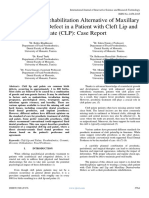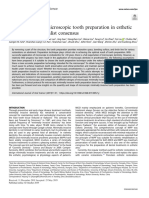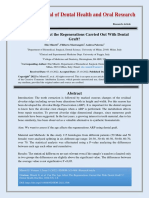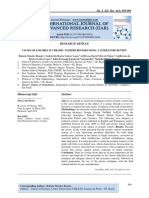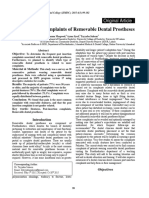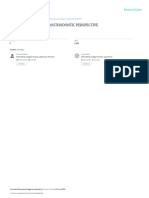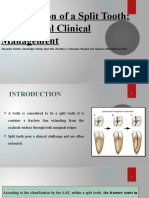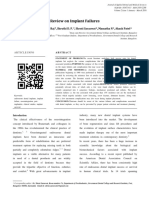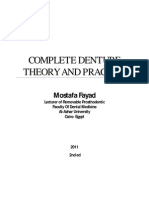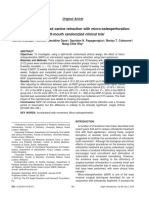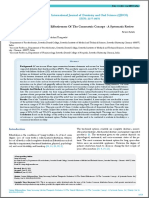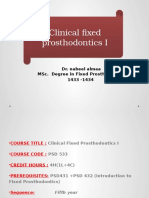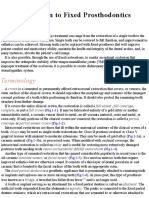Professional Documents
Culture Documents
Restoring One Maxillary Fractured Incisor With A Porcelain Veneer A Case Report
Original Title
Copyright
Available Formats
Share this document
Did you find this document useful?
Is this content inappropriate?
Report this DocumentCopyright:
Available Formats
Restoring One Maxillary Fractured Incisor With A Porcelain Veneer A Case Report
Copyright:
Available Formats
Volume 8, Issue 5, May – 2023 International Journal of Innovative Science and Research Technology
ISSN No:-2456-2165
Restoring One Maxillary Fractured Incisor with a
Porcelain Veneer: A Case Report
1 4
Dr. Balkis khadhraoui Dr. Zohra Nouira ( Professor)
Department of Fixed Prosthodontics, Department of Fixed Prosthodontics,
Dental Faculty of Monastir, Dental Faculty of Monastir,
University of Monastir, Tunisia University of Monastir, Tunisia
2 5
Dr. Zeineb Riahi (Assistant Professor) Dr. Dalenda Hadyaoui( Professor)
Department of Fixed Prosthodontics, Department of Fixed Prosthodontics,
Dental Faculty of Monastir, Dental Faculty of Monastir,
University of Monastir, Tunisia University of Monastir, Tunisia
3 6
Dr. Imen Kalghoum (Assistant Professor) Dr. Belhassen Harzallah ( Professor)
Department of Fixed Prosthodontics, Department of Fixed Prosthodontics,
Dental Faculty of Monastir, Dental Faculty of Monastir,
University of Monastir, Tunisia University of Monastir, Tunisia
7
Dr. Mounir Cherif ( Professor)
Department of Fixed Prosthodontics,
Dental Faculty of Monastir,
University of Monastir, Tunisia
Abstract:- Nowadays, facial appearance takes an When it occurs in the aesthetic area it may represent a
important place in social life especially when it comes to challenge. The dental changes resulting from this clinical
the smile. In fact having even one unaesthetic tooth will occurrence lead to a reduced quality of life of patients
negatively affect the social integration and self-esteem of because it affects their self-esteem (3), (4). The aesthetic
the person particularly among young people. So the factor is even more critical considering the standards of
ultimate challenge for the dentist is to restore the beauty socially imposed, where minimal changes in shape,
patient's smile with the most conservative and aesthetic color and/or positioning have become highly valued.
way. Within the philosophy of less is more and
respecting the therapeutic gradient the indication of When choosing the type of treatment, some clinical
minimally invasive restoration took a place. Dental aspects are key to be considered, like the age of the patient,
porcelain veneer present a suitable option for aesthetic the quality of the remaining tooth structure, the location of
restoration since their introduction in 1983 and this is the fracture line, and the presence of occlusion dysfunction.
based on their strength, longevity, conservative (5), (6).
preparation, aesthetics, and biocompatibility.The
clinical success that the technique can be attributed to Although composite resins can be used in certain
many reasons such as the conservative preparation of clinical cases, all-ceramic restorations offer superior
the teeth; proper selection of ceramics to use; proper esthetic outcomes and durability. Direct restorative
selection of the materials and methods of cementation; materials have limitations in terms of maintaining shine,
and proper planning and communication with the shade, and longevity, whereas all-ceramic restorations are
ceramist. In this article we will illustrate step by step the better equipped to preserve these qualities over time (7).
restoration of one fractured maxillary incisor with a Etching the ceramic surface has been shown to enhance the
feldspathic veneer. long-term bonding effectiveness of composite materials and
tooth tissues, making all-ceramic restorations a viable
Keywords: Central Incisor; Veneer; Bonding; Esthetic,; treatment option (8). Furthermore, by utilizing partial
Dentistry. preparations such as veneers, all-ceramic restorations can
help maintain dental integrity by reducing the amount of
I. INTRODUCTION tooth structure removed (9). In addition, ceramics are often
mentioned as the material of choice in terms of fracture
Dental trauma is a common reason for tissue loss and resistance and color stability (10).
it frequently involves the anterior region (1). Rehabilitation
options for fractured incisors depends on the injuries
characteristics (2).
IJISRT23MAY877 www.ijisrt.com 3769
Volume 8, Issue 5, May – 2023 International Journal of Innovative Science and Research Technology
ISSN No:-2456-2165
II. CASE DESCRIPTION
A 28-year-old female patient attended at the department
of fixed prosthodontics of the dental clinic of Monastir. She
was complainig about the unesthetic appearence of her
maxillary central incisor.
A clinical examination was conducted. It revealed
overlapped central maxillary incisors. The tooth #11 was
rotated medially, with a composite restoration poorly
bonded on the incisal edge. Her Oral hygiene was
satisfactory (Figure 1).
Fig 3 Smile View of the Aesthetic Mock Up
Fig 4 Intra-Oral View of the Prepared Tooth
Fig 1 Intra-oral frontal view
When the diagnostic mock‐up was placed in mouth
An orthodontic treatment followed by prosthodontic the smile line, occlusion, phonetics, and esthetics were
intervention was suggested to the patient but she rejected evaluated.
that option. The minimally invasive ceramic veneers on
tooth #11 was selected. Shade selection was performed and photographs were
taken with and without shade tabs at various angles.
Study impressions were first performed and casted. A
diagnostic wax up was made to prefigure the final result of The preparation was made over the mock up (figure
our esthetic project. (figure 2) 4).
A rounded diamond bur was used to mark three depth
grooves through the mock-up, taking into account that the
minimal thickness of the veneer was 0.3 – 0.5 mm.
Fig 2 Diagnostic Wax-Up
The wax-up was necessary to make modifications in
central teeth arrangement and obtain the patient’s consent
to the treatment plan. A silicon matrix was then performed
to make the intraoral mock up (figure 3).
Fig 5 Full Arch Impression
IJISRT23MAY877 www.ijisrt.com 3770
Volume 8, Issue 5, May – 2023 International Journal of Innovative Science and Research Technology
ISSN No:-2456-2165
A Cervical groove is created to initiate a sketch of the
future cervical finish line. A right angle (butt-joint)
preparation with incisal overlap of 1 to 1.5mm was
achieved to manage enough space providing edge
translucency. Proximal contact areas were not included to
the tooth preparation. Chamfer finish line was maintained
in the cervical region at the level of the gingival margin.
All internal angles were smoothed to reduce stress
concentration.
Fig 7 (b) Application of the Bonding Agent
Layering ceramic (IPS e-max ceram ; Ivoclar
Vivadent AG) was used to guarantee a lifelike play of light
and improve it appearance.
Fig 6 Computer Aided Design of the Ceramic Veneer
Maxillary and full-arch impressions were made using
polyvinyl siloxane material (Zetaplus Zhermack) (figure 5).
The die shade was evaluated using IPS natural die
Material (IvoclarVivadent). The bite registration and
photographs were also sent to the ceramist with a complete
laboratory prescription detailing the required outcome and
patient desires.
The veneer was fabricated with a high-translucency Fig 8 (a) Final Result, Buccal View
Lithium Disilicate reinforced glass ceramic (IPS e-max;
Ivoclar Vivadent AG) using CAD/CAM technique (Figure
6).
Fig 8 (b) Final Result, Lateral View
The prepared tooth was cleaned and the veneer was
tried-in using a transparent try-in paste (Variolink Veneer
try-in paste, Ivoclar).
The form, adaptation and shade match of the
Fig 7 (a) Tooth Surface Etching restoration were checked and the ceramic veneer was
IJISRT23MAY877 www.ijisrt.com 3771
Volume 8, Issue 5, May – 2023 International Journal of Innovative Science and Research Technology
ISSN No:-2456-2165
adhesively luted in accordance with the guidelines of the laminate veneers tolerates stress distribution better than the
manufacturer of the composite resin (Figure 7). butt-joint design (14).
The patient was provided strict oral hygiene With advancements in laboratory techniques and
instructions and regular examination appointments. (Figure dental materials, it is now possible to produce ultrathin
8) feldspathic veneers with thicknesses as small as 0.1-0.5
mm, which can be bonded to tooth structure with minimal
III. DISCUSSION or no preparation required, restoring fractured teeth (15).
Maxillary incisor fracture, especially occurring at a Conservative tooth preparation with ceramic veneers
young age, can cause psychosocial discomfort in addition can help prevent excessive removal of tooth structure and
to esthetic impairment. (1), (9). provide a second opportunity to the tooth in case a
secondary restoration, such as a full coverage crown, is
This case report showed a restoring sequence of a needed in the future. It is important to note that restorations
maxillary central incisor fractured and rotated using are not permanent, and therefore, conservative approaches
ceramic veneer. like ceramic veneers can help preserve the natural tooth
structure.
Orthodontic management followed by prosthetic
treatment would have been the ideal line of treatment for The choice of material for single-tooth porcelain
this case. However, orthodontic treatment was rejected by veneer seems to be case-specific. It is influenced by several
the patient. factors such as the die shade, the opacity of natural teeth
and cost and benefit analysis. Therefore, a thorough
The conservative option with ceramic veneer seems a knowledge of the different materials available for this
reliable and successful alternative in such case, with a purpose, and their applications as limitations will enable the
survival rate of 93.3% after 15 years (10). dentist to select the best option available for each patient’s
needs (16).
Nevertheless, appropriate treatment planning is
needed for such cases. Creating a proper diagnostic wax-up Milled veneers can satisfy esthetic requirements of
is crucial for diagnosing and treating fractured teeth with recovering normal color abutment teeth. The thickness,
veneer restorations (11). shade, and type of ceramic materials become important
variables in manipulating the final color of ceramic
It offers valuable information related to the size laminate veneers because the target color of veneer
discrepancies between healthy and fractured teeth, available restorations and abutment shades cannot always be chosen
restorative space, occlusal scheme, and other required by clinicians. In practice, the thickness of a veneer
treatments in the opposing arch (12). The diagnostic wax- restoration is restricted by the minimal amount of tooth
up can be transferred to the patient's mouth as a mock-up to preparation and target restorative space. In addition, the
allow them to evaluate the proposed restorations both different resin cement shades might be selected to slightly
visually and tactilely. modify the final color of ceramic laminate veneer.
Therefore, clinicians must consider which kind of CAD-
Additionally, the diagnostic wax-up can serve as a CAM material can better recover the optical properties of
treatment tool by providing diagnostic and preparation natural teeth to achieve a good color match .The abutment
guides. The diagnostic guide helps the clinician to tooth color is the primary source of the final esthetic
determine the thickness of the future restoration required to outcome of ceramic veneers (17).
replace the fractured tooth segment, while the reduction Ever since the inception of glass-ceramics in dentistry,
guide can assist in reducing the extension of tooth materials with different compositions have been developed.
preparation if necessary. In both cases, reduction guides However, their popularity surged after the introduction of
were used for planning and executing the final restorations. lithium disilicate glass-ceramic in 1998, marketed as
e.max® (IPS Empress® 2, Ivoclar Vivadent). As compared
The diagnostic wax-up was essential to provide a to feldspathic, ceramic-reinforced polymers, and leucite
mock-up for patients and clinicians to evaluate the glass-ceramics, lithium disilicate-based materials have
proposed restorations visually and tactilely, and the guides, displayed superior mechanical properties (18), (19).
which were fabricated from the diagnostic wax-up, aided in
evaluating the facial space required for the final IV. CONCLUSION
restorations (13).
Restoring fractured maxillary central incisors is
As for the preparation, a cervical chamfer design challenging for many clinicians and the lack of a good
might be a better choice for porcelain veneers because it clinical protocol could be a contributing factor to the
has a lower maximum principle stress, a more uniform unsuccessful management of such cases. Reliable and
stress distribution in the cement layer, and a high clinical positive long-term outcomes have been observed with
success rate. The palatal chamfer design for porcelain adhesive ceramic restorations.
IJISRT23MAY877 www.ijisrt.com 3772
Volume 8, Issue 5, May – 2023 International Journal of Innovative Science and Research Technology
ISSN No:-2456-2165
Advancements in laboratory techniques have made it [8]. BOWEN, R. L., & BOWEN, R. L. (1965).
possible to create ultrathin handcrafted ceramic restorations ADHESIVE BONDING OF VARIOUS
that offer an extremely conservative and aesthetically MATERIALS TO HARD TOOTH TISSUES. I.
pleasing solution for rehabilitating fractured central METHOD OF DETERMINING BOND
incisors. This case report of a fractured central incisor STRENGTH. https://doi.org/10.1177/0022034565
showed that such restorations were clinically successful and 0440041501
met the patients' esthetic requirements. [9]. Edelhoff, D., Sorensen, J. A., Edelhoff, D., &
Sorensen, J. A. (2002). Tooth structure removal
ACKNOWLEDGMENT associated with various preparation designs for
anterior teeth. https://doi.org/10.1067/mpr.2002.124
All authors are members of the Research Laboratory 094
of Occlusodontics and Ceramic Prosthesis LR16ES15 [10]. Peumans, M., Meerbeek, B. V., Lambrechts, P.,
Vanherle, G., Peumans, M., Meerbeek, B. V.,
Conflicts of Interest Vanherle, G. (2000). Porcelain veneers: a review of
The authors declare no conflicts of interest. the literature. https://doi.org/10.1016/s0300-5712
(99)00066-4
Authors’s Contributions [11]. 3rd, L. W. C., Richardson, J. T., 3rd, L. W. C., &
All the authors to the production of this article. They Richardson, J. T. (1985). The diagnostic wax-up: an
read and approved the final version of this manuscript. aid in treatment planning. Retrieved from
https://pubmed.ncbi.nlm.nih.gov/pubmed/3856360
REFERENCES [12]. Yuodelis, R. A., Faucher, R., Yuodelis, R. A., &
Faucher, R. (1980). Provisional restorations: an
[1]. Dewhurst, S. N., Mason, C., Roberts, G. J., integrated approach to periodontics and restorative
Dewhurst, S. N., Mason, C., & Roberts, G. J. dentistry. Retrieved from https://pubmed.ncbi.nlm.
(1998). Emergency treatment of orodental injuries: a nih.gov/pubmed/6988242
review. https://doi.org/10.1016/s0266-4356(98)904 [13]. Preston, J. D., & Preston, J. D. (1976). A systematic
91-0 approach to the control of esthetic form.
[2]. Skeie, M. S., Evjensvold, T., Hoff, T. H., Bårdsen, https://doi.org/10.1016/0022-3913(76)90006-8
A., Skeie, M. S., Evjensvold, T., Bårdsen, A. (2015). [14]. Liu, X. Q., Tan, J. G., Liu, X. Q., & Tan, J. G.
Traumatic dental injuries as reported during school (2021). [Tooth preparation of veneers in the
hours in Bergen. https://doi.org/10.1111/edt.12146 minimally invasive restoration: step by step].
[3]. Almeida S. B., Leonardi D. P., Tomazinho F.S.F., https://doi.org/10.3760/cma.j.cn112144-20210120-
Coelho B.S., Giovanini A.F., Pizzato E. et al. The 00033
relationship of a clinical protocol and emergency [15]. Strassler, H. E., & Strassler, H. E. (2007).
treatment success of dental trauma running head: Minimally invasive porcelain veneers: indications
clinical protocol in dental trauma. RSBO. 2013 Oct- for a conservative esthetic dentistry treatment
Dec;10:313-7. modality. Retrieved from https://pubmed.ncbi.nlm.
[4]. Golai, S., Nimbeni, B., Patil, S. D., Baali, P., nih.gov/pubmed/18069513
Kumar, H., Golai, S., Kumar, H. (2015). Impact of [16]. Gresnigt, M. M. M., Sugii, M. M., Johanns, K. B. F.
Untreated Traumatic Injuries to Anterior Teeth on W., Made, S. A. M. van der, Gresnigt, M. M. M.,
the Oral Health Related Quality of Life As Assessed Sugii, M. M., … Made, S. A. M. van der. (2021).
By Video Based Smiling Patterns in Children. Comparison of conventional ceramic laminate
https://doi.org/10.7860/JCDR/2015/13169.6039 veneers, partial laminate veneers and direct
[5]. Meerbeek, B. V., Vanherle, G., Lambrechts, P., composite resin restorations in fracture strength after
Braem, M., Meerbeek, B. V., Vanherle, G., Braem, aging. https://doi.org/10.1016/j.jmbbm.2020.104172
M. (1992). Dentin- and enamel-bonding agents. [17]. Su, Y., Xin, M., Chen, X., Xing, W., Su, Y., Xin,
Retrieved from https://pubmed.ncbi.nlm.nih.gov/ M., Xing, W. (2021). Effect of CAD-CAM ceramic
pubmed/1520921 materials on the color match of veneer restorations.
[6]. Pashley, D. H., Ciucchi, B., Sano, H., Horner, J. A., https://doi.org/10.1016/j.prosdent.2021.04.029
Pashley, D. H., Ciucchi, B., … Horner, J. A. (1993). [18]. 2nd, R. A. G., Pelletier, L., Campbell, S., Pober, R.,
Permeability of dentin to adhesive agents. Retrieved 2nd, R. A. G., Pelletier, L., Pober, R. (1995).
from https://pubmed.ncbi.nlm.nih.gov/pubmed/827 Flexural strength of an infused ceramic, glass
2500 ceramic, and feldspathic porcelain. https://doi.org/
[7]. D’Arcangelo, C., Angelis, F. D., Vadini, M., 10.1016/s0022-3913(05)80067-8
D’Amario, M., D’Arcangelo, C., Angelis, F. D., [19]. Bajraktarova-Valjakova, E., Korunoska-Stevkovska,
D’Amario, M. (2012). Clinical evaluation on V., Kapusevska, B., Gigovski, N., Bajraktarova-
porcelain laminate veneers bonded with light-cured Misevska, C., & Grozdanov, A.
composite: results up to 7 years. https://doi.org/10. (2018). Contemporary Dental Ceramic Materials, A
1007/s00784-011-0593-0 Review: Chemical Composition, Physical and
Mechanical Properties, Indications for Use.
https://doi.org/10.3889/oamjms.2018.378
IJISRT23MAY877 www.ijisrt.com 3773
You might also like
- Prosthodontic Rehabilitation Alternative of Maxillary Dentoalveolar Defect in A Patient With Cleft Lip and Palate (CLP) Case ReportDocument5 pagesProsthodontic Rehabilitation Alternative of Maxillary Dentoalveolar Defect in A Patient With Cleft Lip and Palate (CLP) Case ReportInternational Journal of Innovative Science and Research TechnologyNo ratings yet
- Tanpa Judul PDFDocument7 pagesTanpa Judul PDFnadyashintakasihNo ratings yet
- Short ImplantsFrom EverandShort ImplantsBoyd J. TomasettiNo ratings yet
- Implants in Esthetic ZoneDocument10 pagesImplants in Esthetic ZoneInternational Journal of Innovative Science and Research TechnologyNo ratings yet
- Peri-Implant Complications: A Clinical Guide to Diagnosis and TreatmentFrom EverandPeri-Implant Complications: A Clinical Guide to Diagnosis and TreatmentNo ratings yet
- SCs Based Approaches in DentistryDocument10 pagesSCs Based Approaches in Dentistryradwam123No ratings yet
- Esthetic Oral Rehabilitation with Veneers: A Guide to Treatment Preparation and Clinical ConceptsFrom EverandEsthetic Oral Rehabilitation with Veneers: A Guide to Treatment Preparation and Clinical ConceptsRichard D. TrushkowskyNo ratings yet
- A Technique For Relining Transitional Removable Denture - A Case ReportDocument4 pagesA Technique For Relining Transitional Removable Denture - A Case ReportEduard Gabriel GavrilăNo ratings yet
- Recurrent Diastema Closure After Orthodontic Treatment With CeramicDocument4 pagesRecurrent Diastema Closure After Orthodontic Treatment With Ceramicyuana dnsNo ratings yet
- Veneer Series PT 1Document6 pagesVeneer Series PT 1Cornelia Gabriela OnuțNo ratings yet
- The "Index Technique" in Worn Dentition - A New and Conservative ApproachDocument32 pagesThe "Index Technique" in Worn Dentition - A New and Conservative ApproachFilipe Queiroz100% (2)
- A Case Report On Andrew's BridgeDocument5 pagesA Case Report On Andrew's BridgeEvoNo ratings yet
- The "Index Technique" in Worn Dentition: A New and Conservative ApproachDocument32 pagesThe "Index Technique" in Worn Dentition: A New and Conservative ApproachHektor Hak100% (1)
- A Withinpatient Comparative Study of The Influence of Number and Distribution of Ball Attachment Retained Mandibular Overdenture 1011Document6 pagesA Withinpatient Comparative Study of The Influence of Number and Distribution of Ball Attachment Retained Mandibular Overdenture 1011dentureNo ratings yet
- Minimal Invasive Microscopic Tooth Preparation in Esthetic Restoration, A Specialist Consensus PDFDocument11 pagesMinimal Invasive Microscopic Tooth Preparation in Esthetic Restoration, A Specialist Consensus PDFBelen AntoniaNo ratings yet
- Management of Anterior Teeth Fracture With Preservation of Fractured Fragment-Two Case ReportsDocument9 pagesManagement of Anterior Teeth Fracture With Preservation of Fractured Fragment-Two Case ReportsMonica MarcilliaNo ratings yet
- Review of Dental ImplantDocument10 pagesReview of Dental Implantmar100% (1)
- Todentj 13 137Document6 pagesTodentj 13 137luis alejandroNo ratings yet
- Full Mouth Zirconia Based Implant Supported Fixed Dental Prostheses. Five Year - Results of A Clinical Pilot StudyDocument5 pagesFull Mouth Zirconia Based Implant Supported Fixed Dental Prostheses. Five Year - Results of A Clinical Pilot StudyAndres CurraNo ratings yet
- I014634952 PDFDocument4 pagesI014634952 PDFGowriKrishnaraoNo ratings yet
- Article 1500408825Document7 pagesArticle 1500408825fennilubisNo ratings yet
- Pin-Retained Restoration With Resin Bonded Composite of A Badly Broken ToothDocument3 pagesPin-Retained Restoration With Resin Bonded Composite of A Badly Broken ToothIOSRjournalNo ratings yet
- Mockup Driven Designing of Fullmouth Implantsupported Metalceramic Fixed Prostheses 2161 1122.1000204 PDFDocument8 pagesMockup Driven Designing of Fullmouth Implantsupported Metalceramic Fixed Prostheses 2161 1122.1000204 PDFgattusoNo ratings yet
- JCDP 20 1108Document10 pagesJCDP 20 1108snkidNo ratings yet
- Intentional Re-Plantation of A Vertically Fractured Tooth Repaired With An Adhesive ResinDocument10 pagesIntentional Re-Plantation of A Vertically Fractured Tooth Repaired With An Adhesive Resinveena rNo ratings yet
- Direct Restoration of Endodontically Treated Teeth A Brief Sumary of Materials and TechnoquesDocument8 pagesDirect Restoration of Endodontically Treated Teeth A Brief Sumary of Materials and Technoquesmaroun ghalebNo ratings yet
- Can The Age Affect The Regenerations Carried Out With Dental GraftDocument8 pagesCan The Age Affect The Regenerations Carried Out With Dental GraftAthenaeum Scientific PublishersNo ratings yet
- A New Method For Selecting Maxillary Anterior Artificial Teeth in Complete Dental ProsthesesDocument7 pagesA New Method For Selecting Maxillary Anterior Artificial Teeth in Complete Dental ProsthesesInternational Journal of Innovative Science and Research TechnologyNo ratings yet
- 1 s2.0 S1991790221001045 MainDocument10 pages1 s2.0 S1991790221001045 MainAazariNo ratings yet
- 34 Journal of Periodontology - 2018 - H Mmerle - The Etiology of Hard and Soft Tissue Deficiencies at Dental Implants ADocument13 pages34 Journal of Periodontology - 2018 - H Mmerle - The Etiology of Hard and Soft Tissue Deficiencies at Dental Implants AMax Flores RuizNo ratings yet
- Causes of Failures in Ceramic Veneers ReDocument11 pagesCauses of Failures in Ceramic Veneers ReSawab IsmaelNo ratings yet
- Post Insertion Complaints of Removable Dental Prostheses: Original ArticleDocument4 pagesPost Insertion Complaints of Removable Dental Prostheses: Original ArticleAhmed KnaniNo ratings yet
- Malo ArticleDocument6 pagesMalo Articleishita parekhNo ratings yet
- Content ServerDocument6 pagesContent ServerNicoll SQNo ratings yet
- Ortodoncia y CarillasDocument4 pagesOrtodoncia y CarillasLiz StephanyNo ratings yet
- Aesthetics in Complete Denture - A REVIEWDocument2 pagesAesthetics in Complete Denture - A REVIEWInternational Journal of Innovative Science and Research TechnologyNo ratings yet
- Adhesive Restoration of Anterior Endodontically Treated TeethDocument10 pagesAdhesive Restoration of Anterior Endodontically Treated TeethEugenioNo ratings yet
- Dentalimplant ProsthodontistperspectiveDocument8 pagesDentalimplant Prosthodontistperspectivekl5973333No ratings yet
- Preventive Prosthodontics: Combination of Tooth Supported BPS Overdenture & Flexible Removable Partial DentureDocument5 pagesPreventive Prosthodontics: Combination of Tooth Supported BPS Overdenture & Flexible Removable Partial DentureInddah NiiNo ratings yet
- JOHCD-Maintenance of Implant SupportedDocument3 pagesJOHCD-Maintenance of Implant SupportedManoj HumagainNo ratings yet
- Basal Implants in The Mandibular Esthetic Zone A Case SeriesDocument6 pagesBasal Implants in The Mandibular Esthetic Zone A Case SeriesInternational Journal of Innovative Science and Research TechnologyNo ratings yet
- J Esthet Restor Dent - 2016 - Vadini - No Prep Rehabilitation of Fractured Maxillary Incisors With Partial VeneersDocument8 pagesJ Esthet Restor Dent - 2016 - Vadini - No Prep Rehabilitation of Fractured Maxillary Incisors With Partial VeneersPetru GhimusNo ratings yet
- Implant PlanificactioDocument16 pagesImplant PlanificactioJUAN GUILLERMO MORENO CASTILLONo ratings yet
- Anterior Esthetic Restorations Using Direct Composite Restoration A Case ReportDocument6 pagesAnterior Esthetic Restorations Using Direct Composite Restoration A Case ReportkinayungNo ratings yet
- Aesthetic Replacement For Missing Primary Teeth A Novel ApproachDocument3 pagesAesthetic Replacement For Missing Primary Teeth A Novel ApproachAaser AhmedNo ratings yet
- Article1404395371 - Shibu and RajanDocument3 pagesArticle1404395371 - Shibu and RajanRuchi ShahNo ratings yet
- Comparative Sealing Ability of Three Temporary Coronal Restoration Materials Used For The Access Cavity of Endodontically Treated TeethDocument2 pagesComparative Sealing Ability of Three Temporary Coronal Restoration Materials Used For The Access Cavity of Endodontically Treated TeethbogdimNo ratings yet
- The Orthodontics Effective RoleDocument31 pagesThe Orthodontics Effective RoleHamza BelhajNo ratings yet
- Internal Root Resorption Sixty Four ThouDocument8 pagesInternal Root Resorption Sixty Four ThouMihaela TuculinaNo ratings yet
- Preservation of A Split Tooth - JC 3.1Document49 pagesPreservation of A Split Tooth - JC 3.1veena rNo ratings yet
- A Review On Implant FailuresDocument7 pagesA Review On Implant FailuresMario Troncoso AndersennNo ratings yet
- Completedenture Theory and PracticeDocument1,233 pagesCompletedenture Theory and PracticeMostafa Fayad100% (7)
- Chen Buser JOMI2014Document31 pagesChen Buser JOMI2014ALeja ArévaLoNo ratings yet
- Forced Eruption of Adjoining Maxillary Premolars Using A Removable Orthodontic Appliance: A Case ReportDocument4 pagesForced Eruption of Adjoining Maxillary Premolars Using A Removable Orthodontic Appliance: A Case Reportikeuchi_ogawaNo ratings yet
- Flexible Denture Base Material A Viable AlternativDocument5 pagesFlexible Denture Base Material A Viable AlternativRaluca ChisciucNo ratings yet
- A Study of Buccal Wall NevinsDocument13 pagesA Study of Buccal Wall NevinsAlejandro FerreyraNo ratings yet
- Table Top Tooth Wear - A Systematic Review of Treatment OptionsDocument8 pagesTable Top Tooth Wear - A Systematic Review of Treatment OptionsZardasht NajmadineNo ratings yet
- Mini-Implant Supported Canine Retraction With Micro-Osteoperforation: A Split-Mouth Randomized Clinical TrialDocument7 pagesMini-Implant Supported Canine Retraction With Micro-Osteoperforation: A Split-Mouth Randomized Clinical Triallaura velez0% (1)
- Ijdos 2377 8075 08 6049Document6 pagesIjdos 2377 8075 08 6049ARAVINDAN GEETHA KRRISHNANNo ratings yet
- Cyber Security Awareness and Educational Outcomes of Grade 4 LearnersDocument33 pagesCyber Security Awareness and Educational Outcomes of Grade 4 LearnersInternational Journal of Innovative Science and Research TechnologyNo ratings yet
- Factors Influencing The Use of Improved Maize Seed and Participation in The Seed Demonstration Program by Smallholder Farmers in Kwali Area Council Abuja, NigeriaDocument6 pagesFactors Influencing The Use of Improved Maize Seed and Participation in The Seed Demonstration Program by Smallholder Farmers in Kwali Area Council Abuja, NigeriaInternational Journal of Innovative Science and Research TechnologyNo ratings yet
- Parastomal Hernia: A Case Report, Repaired by Modified Laparascopic Sugarbaker TechniqueDocument2 pagesParastomal Hernia: A Case Report, Repaired by Modified Laparascopic Sugarbaker TechniqueInternational Journal of Innovative Science and Research TechnologyNo ratings yet
- Smart Health Care SystemDocument8 pagesSmart Health Care SystemInternational Journal of Innovative Science and Research TechnologyNo ratings yet
- Blockchain Based Decentralized ApplicationDocument7 pagesBlockchain Based Decentralized ApplicationInternational Journal of Innovative Science and Research TechnologyNo ratings yet
- Unmasking Phishing Threats Through Cutting-Edge Machine LearningDocument8 pagesUnmasking Phishing Threats Through Cutting-Edge Machine LearningInternational Journal of Innovative Science and Research TechnologyNo ratings yet
- Study Assessing Viability of Installing 20kw Solar Power For The Electrical & Electronic Engineering Department Rufus Giwa Polytechnic OwoDocument6 pagesStudy Assessing Viability of Installing 20kw Solar Power For The Electrical & Electronic Engineering Department Rufus Giwa Polytechnic OwoInternational Journal of Innovative Science and Research TechnologyNo ratings yet
- An Industry That Capitalizes Off of Women's Insecurities?Document8 pagesAn Industry That Capitalizes Off of Women's Insecurities?International Journal of Innovative Science and Research TechnologyNo ratings yet
- Visual Water: An Integration of App and Web To Understand Chemical ElementsDocument5 pagesVisual Water: An Integration of App and Web To Understand Chemical ElementsInternational Journal of Innovative Science and Research TechnologyNo ratings yet
- Insights Into Nipah Virus: A Review of Epidemiology, Pathogenesis, and Therapeutic AdvancesDocument8 pagesInsights Into Nipah Virus: A Review of Epidemiology, Pathogenesis, and Therapeutic AdvancesInternational Journal of Innovative Science and Research TechnologyNo ratings yet
- Smart Cities: Boosting Economic Growth Through Innovation and EfficiencyDocument19 pagesSmart Cities: Boosting Economic Growth Through Innovation and EfficiencyInternational Journal of Innovative Science and Research TechnologyNo ratings yet
- Parkinson's Detection Using Voice Features and Spiral DrawingsDocument5 pagesParkinson's Detection Using Voice Features and Spiral DrawingsInternational Journal of Innovative Science and Research TechnologyNo ratings yet
- Impact of Silver Nanoparticles Infused in Blood in A Stenosed Artery Under The Effect of Magnetic Field Imp. of Silver Nano. Inf. in Blood in A Sten. Art. Under The Eff. of Mag. FieldDocument6 pagesImpact of Silver Nanoparticles Infused in Blood in A Stenosed Artery Under The Effect of Magnetic Field Imp. of Silver Nano. Inf. in Blood in A Sten. Art. Under The Eff. of Mag. FieldInternational Journal of Innovative Science and Research TechnologyNo ratings yet
- Compact and Wearable Ventilator System For Enhanced Patient CareDocument4 pagesCompact and Wearable Ventilator System For Enhanced Patient CareInternational Journal of Innovative Science and Research TechnologyNo ratings yet
- Air Quality Index Prediction Using Bi-LSTMDocument8 pagesAir Quality Index Prediction Using Bi-LSTMInternational Journal of Innovative Science and Research TechnologyNo ratings yet
- Predict The Heart Attack Possibilities Using Machine LearningDocument2 pagesPredict The Heart Attack Possibilities Using Machine LearningInternational Journal of Innovative Science and Research TechnologyNo ratings yet
- Investigating Factors Influencing Employee Absenteeism: A Case Study of Secondary Schools in MuscatDocument16 pagesInvestigating Factors Influencing Employee Absenteeism: A Case Study of Secondary Schools in MuscatInternational Journal of Innovative Science and Research TechnologyNo ratings yet
- The Relationship Between Teacher Reflective Practice and Students Engagement in The Public Elementary SchoolDocument31 pagesThe Relationship Between Teacher Reflective Practice and Students Engagement in The Public Elementary SchoolInternational Journal of Innovative Science and Research TechnologyNo ratings yet
- Diabetic Retinopathy Stage Detection Using CNN and Inception V3Document9 pagesDiabetic Retinopathy Stage Detection Using CNN and Inception V3International Journal of Innovative Science and Research TechnologyNo ratings yet
- An Analysis On Mental Health Issues Among IndividualsDocument6 pagesAn Analysis On Mental Health Issues Among IndividualsInternational Journal of Innovative Science and Research TechnologyNo ratings yet
- Implications of Adnexal Invasions in Primary Extramammary Paget's Disease: A Systematic ReviewDocument6 pagesImplications of Adnexal Invasions in Primary Extramammary Paget's Disease: A Systematic ReviewInternational Journal of Innovative Science and Research TechnologyNo ratings yet
- Harnessing Open Innovation For Translating Global Languages Into Indian LanuagesDocument7 pagesHarnessing Open Innovation For Translating Global Languages Into Indian LanuagesInternational Journal of Innovative Science and Research TechnologyNo ratings yet
- Keywords:-Ibadhy Chooranam, Cataract, Kann Kasam,: Siddha Medicine, Kann NoigalDocument7 pagesKeywords:-Ibadhy Chooranam, Cataract, Kann Kasam,: Siddha Medicine, Kann NoigalInternational Journal of Innovative Science and Research TechnologyNo ratings yet
- The Utilization of Date Palm (Phoenix Dactylifera) Leaf Fiber As A Main Component in Making An Improvised Water FilterDocument11 pagesThe Utilization of Date Palm (Phoenix Dactylifera) Leaf Fiber As A Main Component in Making An Improvised Water FilterInternational Journal of Innovative Science and Research TechnologyNo ratings yet
- The Impact of Digital Marketing Dimensions On Customer SatisfactionDocument6 pagesThe Impact of Digital Marketing Dimensions On Customer SatisfactionInternational Journal of Innovative Science and Research TechnologyNo ratings yet
- Dense Wavelength Division Multiplexing (DWDM) in IT Networks: A Leap Beyond Synchronous Digital Hierarchy (SDH)Document2 pagesDense Wavelength Division Multiplexing (DWDM) in IT Networks: A Leap Beyond Synchronous Digital Hierarchy (SDH)International Journal of Innovative Science and Research TechnologyNo ratings yet
- Advancing Healthcare Predictions: Harnessing Machine Learning For Accurate Health Index PrognosisDocument8 pagesAdvancing Healthcare Predictions: Harnessing Machine Learning For Accurate Health Index PrognosisInternational Journal of Innovative Science and Research TechnologyNo ratings yet
- The Making of Object Recognition Eyeglasses For The Visually Impaired Using Image AIDocument6 pagesThe Making of Object Recognition Eyeglasses For The Visually Impaired Using Image AIInternational Journal of Innovative Science and Research TechnologyNo ratings yet
- Formulation and Evaluation of Poly Herbal Body ScrubDocument6 pagesFormulation and Evaluation of Poly Herbal Body ScrubInternational Journal of Innovative Science and Research TechnologyNo ratings yet
- Terracing As An Old-Style Scheme of Soil Water Preservation in Djingliya-Mandara Mountains - CameroonDocument14 pagesTerracing As An Old-Style Scheme of Soil Water Preservation in Djingliya-Mandara Mountains - CameroonInternational Journal of Innovative Science and Research TechnologyNo ratings yet
- IJRID1063Document4 pagesIJRID1063Wulan Rambitan100% (1)
- Influence of Different Preparation Forms On The Loading-Bearing Capacity of Zirconia Cantilever FDPs. A Laboratory Study. Bishti. 2018. JPRDocument7 pagesInfluence of Different Preparation Forms On The Loading-Bearing Capacity of Zirconia Cantilever FDPs. A Laboratory Study. Bishti. 2018. JPRValeria CrespoNo ratings yet
- The Resin-Bonded Fixed Partial Denture As The First Treatment Consideration To Replace A Missing ToothDocument3 pagesThe Resin-Bonded Fixed Partial Denture As The First Treatment Consideration To Replace A Missing ToothAngelia PratiwiNo ratings yet
- ReferencesDocument5 pagesReferencesJhanelle S. Dixon-LairdNo ratings yet
- Retainers & ConnectorsDocument25 pagesRetainers & ConnectorsBindu VaithilingamNo ratings yet
- Occlusal Considerations in Full Arch Implant Supported Fixed Prosthetics (Dentistry) (Z-Library)Document12 pagesOcclusal Considerations in Full Arch Implant Supported Fixed Prosthetics (Dentistry) (Z-Library)Đoàn Quang NhậtNo ratings yet
- Understanding Problems and Failures in TSFDP: Peer Review StatusDocument7 pagesUnderstanding Problems and Failures in TSFDP: Peer Review StatusbkprosthoNo ratings yet
- Repairing Porcelain PDFDocument10 pagesRepairing Porcelain PDFChristie Maria ThomasNo ratings yet
- 6 Restorationoftheendodonticallytreatedtooth 101219205957 Phpapp02Document100 pages6 Restorationoftheendodonticallytreatedtooth 101219205957 Phpapp02JASPREETKAUR0410100% (1)
- PapersDocument19 pagesPapersvarunNo ratings yet
- JC 11 A Systematic Review of The Survival and ComplicationDocument41 pagesJC 11 A Systematic Review of The Survival and ComplicationMrinmayee ThakurNo ratings yet
- Air Force Manual Version 2Document338 pagesAir Force Manual Version 2Igin Ismat100% (8)
- 20.1. Treatment Planning. Retention of The Natural Dentition and The Replacement of Missing Teeth. Endodontics Colleagues For Excellence (A.A.E.)Document8 pages20.1. Treatment Planning. Retention of The Natural Dentition and The Replacement of Missing Teeth. Endodontics Colleagues For Excellence (A.A.E.)Ixaya ZisuyatraNo ratings yet
- Diagnosis and Treatment Plan in FPD - PPTX NewDocument99 pagesDiagnosis and Treatment Plan in FPD - PPTX Newreshma shaikNo ratings yet
- 6-Year-Follo Up. 3 Steps Techniques. Francesca Valati-1 PDFDocument25 pages6-Year-Follo Up. 3 Steps Techniques. Francesca Valati-1 PDFAdriana CoronadoNo ratings yet
- Tooth Prep PrinciplesDocument47 pagesTooth Prep PrinciplesAME DENTAL COLLEGE RAICHUR, KARNATAKANo ratings yet
- Batasan Ilmu ProstodonsiaDocument22 pagesBatasan Ilmu ProstodonsiaAlbis'i Fatinzaki TsuroyyaNo ratings yet
- MdsDocument356 pagesMdsARJUN SreenivasNo ratings yet
- DR Ghazy 2013 - 2014 Fixed Prosthodontics IntroductionDocument21 pagesDR Ghazy 2013 - 2014 Fixed Prosthodontics IntroductionMohamed Hamed GhazyNo ratings yet
- Case Report Resin-Bonded Bridge: Conservative Treatment Option For Single Tooth ReplacementDocument5 pagesCase Report Resin-Bonded Bridge: Conservative Treatment Option For Single Tooth ReplacementAisha MutiaraNo ratings yet
- The Prosthodontic Management of Endodontically Treated Teeth - A Literature Review. Part I. SuccesDocument8 pagesThe Prosthodontic Management of Endodontically Treated Teeth - A Literature Review. Part I. SucceskochikaghochiNo ratings yet
- Taper and Relative Parallelism of Abutment Teeth: A Key To Success in Fixed Partial DenturesDocument5 pagesTaper and Relative Parallelism of Abutment Teeth: A Key To Success in Fixed Partial DenturesIrzam PratamaNo ratings yet
- Ada CodesDocument4 pagesAda CodestedyNo ratings yet
- Clinical Fixed Prosthodontics IDocument24 pagesClinical Fixed Prosthodontics Isiddu76No ratings yet
- 01 - An Introduction To Fixed ProsthodonticsDocument21 pages01 - An Introduction To Fixed ProsthodonticsDominator_mdNo ratings yet
- Fixed Partial DenturesDocument19 pagesFixed Partial DenturesDaniela LeonteNo ratings yet
- Diagnosis and Treatment Planning in Fixed Partial Dentures / Orthodontic Courses by Indian Dental AcademyDocument34 pagesDiagnosis and Treatment Planning in Fixed Partial Dentures / Orthodontic Courses by Indian Dental Academyindian dental academy100% (1)
- Finish LineDocument3 pagesFinish LineSgNo ratings yet
- Restoration of Endodontically Treated TeethDocument194 pagesRestoration of Endodontically Treated TeethBharti DuaNo ratings yet
- Making Predictable Removable Prosthodontics With Traditional and Digital TechniquesDocument11 pagesMaking Predictable Removable Prosthodontics With Traditional and Digital TechniquesCaglarBursaNo ratings yet
